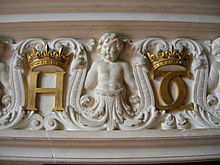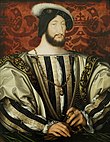Henry II of France
Henry II of France (Saint-Germain-en-Laye, March 31, 1519-Paris, July 10, 1559), fourth son of Francis I and Claudia of France, was recognized duke of Brittany in 1536 (without coronation), and crowned king of France at Reims in 1547.
Biography
Early years
Henry was born in the castle of Saint-Germain-en-Laye, near Paris, as the second son of Francis I of France and Claudia, Duchess of Brittany, daughter of Louis XII of France and Anne of Brittany. His father was captured in the Battle of Pavia by his enemy, Charles V of the Holy Roman Empire, forcing him to sign the Treaty of Madrid, so Henry and his older brother Francis, Dauphin and Duke of Brittany, remained hostages. from 1526 to 1530 as a guarantee of compliance with what was agreed. It is not entirely clear where they stayed, since they were accompanied by a large entourage that must also have been housed and retained, although it seems that they were always in fortresses that belonged to the Fernández de Velasco family, dukes of Frías and constables of Castile. They were the castles of Villalba de los Alcores (1528), Ampudia (1528), Velasco (the palace of the Constables in Villalpando), Berlanga, Castilnovo and Pedraza (1528-1530).
After the death of his brother in 1536, Henry succeeded him as dauphin and duke of Brittany, without ruling in Brittany, since his father was the usufructuary. After the death of his father, he inherited the throne of France. He was erratic in alliance politics and, initially, a fervent defender of the Catholic faith against the Protestant Reformation. He bitterly fought the Huguenots but then tolerated them and allied himself with the Calvinists. He condemned non-Catholic books in 1551, prohibiting their circulation and sale, and maintained the confrontation against Charles V with a unique alliance with the Ottoman Empire. He took Metz despite the siege of the Spanish king and defended Paris against the emperor, but all the war efforts bankrupted the Crown.
Marriage


He married Catherine de' Medici in 1533, with whom he had ten children, while maintaining a love relationship with Diana of Poitiers, which became official in 1536. Diana of Poitiers exerted a notable influence on the king and, although in a different order, he was also influenced by the constable Anne de Montmorency, as well as his nephews (Gaspar de Coligny, François d'Andelot, and Cardinal Odet de Châtillon) who enjoyed the full confidence of Henry II.
He negotiated the rescue of Boulogne with the English in 1550. Through the Treaty of Chambord in 1552, he secured the alliance of France with the Protestant princes of the Holy Roman Empire against Charles V and was authorized to take the three episcopal cities and imperial cities of Metz, Toul and Verdun, in Lorraine.
In 1552 he occupied the Three Bishoprics, which belonged to the Holy Roman Empire, whose definitive annexation to France was not recognized until 1648 when the Peace of Westphalia was signed.
In 1558 the Duke of Guise and the French navy managed to recover Calais, the last possession of the English in French territory.
Last years and death

He suffered several setbacks at the end of his short reign. He was defeated in Italy and in the Netherlands by Spain. He was forced to accept, in 1559, the Peace of Cateau-Cambrésis and to renounce, definitively, his Italian possessions.
He died in 1559. During a tournament against Gabriel, Earl of Montgomery, held on the occasion of the wedding of his daughter Isabel to Philip II of Spain, he was seriously wounded in the eye by his spear. He was treated by the best doctors and surgeons. Ambroise Paré was authorized to reproduce the wound on some condemned men to investigate how and in what way to cure it, without obtaining any results. Philip II sent Andrés Vesalius from Brussels, who did not arrive in time to try to save the king's life, since he had already died upon his arrival.
He was succeeded by his eldest son, Francis II of France.
His reign, sometimes considered faded like his personality, witnessed, however, the defeat of Charles V against whom his father, Francis I, had fought unsuccessfully. And, unintentionally, he was the generator of France's Wars of Religion because of his unwavering defense of the Catholic faith against the Protestant Reformation. This death is believed to have been predicted by Nostradamus in his quatrain: —the young lion will counteract the old lion on the battlefield, then in a golden cage he will gouge out its eyes and the old lion will die a cruel death—.
Offspring
From his marriage to Catherine de' Medici he had ten children:
- Francisco (1544-1560), King of France from 1559 to 1560.
- Isabel (1546-1568), married to Felipe II of Spain (1559).
- Claudia (1547-1575), married to Carlos III de Lorena.
- Luis (1549-1550), Duke of Orleans.
- Carlos (1550-1574), Duke of Orleans (1550-1560) and King of France from 1560 to 1574.
- Enrique (Alejandro Eduardo) (1551-1589), Duke of Anjou (1551-1576), Orleans (1560-1576), King of Poland (1573-1574) and King of France (1574-1589).
- Margarita (1553-1615), married to Henry IV of France in 1572.
- Hercules (Francisco) (1555-1584), Duke of Alençon and Anjou.
- Victoria and Juana (1556).
From his relationship with the Piedmontese Filippa Duci, when he was still a dauphin, he had a legitimized daughter:
- Diana de France (1538-1619), duchess of Châtellerault, Angulema and Étampes.
From his relationship with the Baroness de Fonttete, Nicole de Savigny, he had a son who was not legitimized but was recognized by his father:
- Enrique de Valois-San-Rémiborn in 1557 in Paris.
Ancestors of Henry II of France
| 16. Luis de Valois | ||||||||||||||||
| 8. Juan de Orleans | ||||||||||||||||
| 17. Valentina Visconti | ||||||||||||||||
| 4. Carlos de Orleans | ||||||||||||||||
| 18. Alano IX de Rohan | ||||||||||||||||
| 9. Marguarita de Rohan | ||||||||||||||||
| 19. Margarita de Brittany | ||||||||||||||||
| 2. Francisco I de France | ||||||||||||||||
| 20. Luis de Saboya | ||||||||||||||||
| 10. Philip II of Saboya | ||||||||||||||||
| 21. Ana de Lusignan | ||||||||||||||||
| 5. Luisa de Saboya | ||||||||||||||||
| 22. Carlos I de Borbón | ||||||||||||||||
| 11. Margarita de Borbón | ||||||||||||||||
| 23. Inés de Borgoña | ||||||||||||||||
| 1. Henry II of France | ||||||||||||||||
| 24. Luis de Valois (= 16) | ||||||||||||||||
| 12. Carlos I de Orleans | ||||||||||||||||
| 25. Valentina Visconti (= 17) | ||||||||||||||||
| 6. Louis XII of France | ||||||||||||||||
| 26. Adolfo I de Cleves | ||||||||||||||||
| 13. María de Cleves | ||||||||||||||||
| 27. Mary of Burgundy | ||||||||||||||||
| 3. Claudia de France | ||||||||||||||||
| 28. Ricardo de Brittany | ||||||||||||||||
| 14. Francis II of Britain | ||||||||||||||||
| 29. Margarita de Orleans | ||||||||||||||||
| 7. Ana de Brittany | ||||||||||||||||
| 30. Gaston IV of Foix | ||||||||||||||||
| 15. Margarita de Foix | ||||||||||||||||
| 31. Leonor I de Navarra | ||||||||||||||||
Succession
| Predecessor: Francisco I |  1547 - 1559 | Successor: Francis II |
Contenido relacionado
Nicholas II
Elizabeth I
Antigua Guatemala

